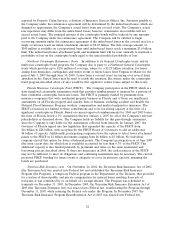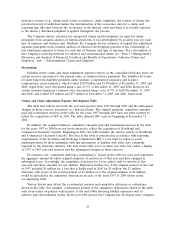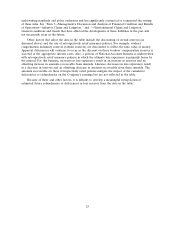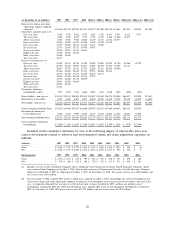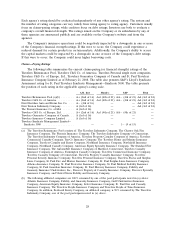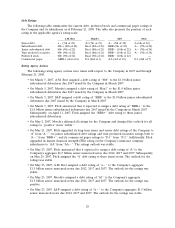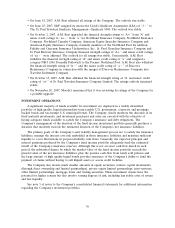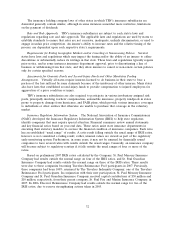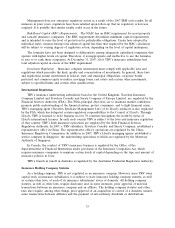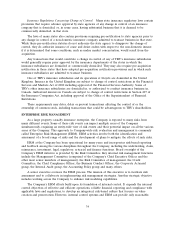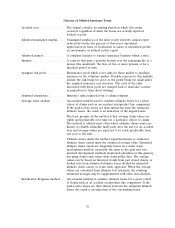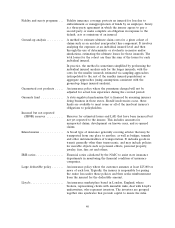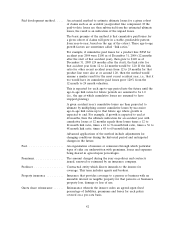Travelers 2007 Annual Report Download - page 44
Download and view the complete annual report
Please find page 44 of the 2007 Travelers annual report below. You can navigate through the pages in the report by either clicking on the pages listed below, or by using the keyword search tool below to find specific information within the annual report.The insurance holding company laws of other states in which TRV’s insurance subsidiaries are
domiciled generally contain similar, although in some instances somewhat more restrictive, limitations
on the payment of dividends.
Rate and Rule Approvals. TRV’s insurance subsidiaries are subject to each state’s laws and
regulations regarding rate and rule approvals. The applicable laws and regulations are used by states to
establish standards to ensure that rates are not excessive, inadequate, unfairly discriminatory, or used to
engage in unfair price competition. An insurer’s ability to increase rates and the relative timing of the
process, are dependent upon each respective state’s requirements.
Requirements for Exiting Geographic Markets and/or Canceling or Nonrenewing Policies. Several
states have laws and regulations which may impact the timing and/or the ability of an insurer to either
discontinue or substantially reduce its writings in that state. These laws and regulations typically require
prior notice, and in some instances insurance department approval, prior to discontinuing a line of
business or withdrawing from that state, and they allow insurers to cancel or non-renew certain policies
only for certain specified reasons.
Assessments for Guaranty Funds and Second-Injury Funds and Other Mandatory Pooling
Arrangements. Virtually all states require insurers licensed to do business in their state to bear a
portion of the loss suffered by some claimants because of the insolvency of other insurers. Many states
also have laws that established second-injury funds to provide compensation to injured employees for
aggravation of a prior condition or injury.
TRV’s insurance subsidiaries are also required to participate in various involuntary assigned risk
pools, principally involving workers’ compensation, automobile insurance, property windpools in states
prone to property damage from hurricanes, and FAIR plans, which provide various insurance coverages
to individuals or other entities that otherwise are unable to purchase that coverage in the voluntary
market.
Insurance Regulatory Information System. The National Association of Insurance Commissioners
(NAIC) developed the Insurance Regulatory Information System (IRIS) to help state regulators
identify companies that may require special attention. Financial examiners review annual statements
and key financial ratios based on year-end data. These ratios assist state insurance departments in
executing their statutory mandate to oversee the financial condition of insurance companies. Each ratio
has an established ‘‘usual range’’ of results. A ratio result falling outside the usual range of IRIS ratios,
however, is not considered a failing result; rather, unusual values are viewed as part of the regulatory
early monitoring system. Furthermore, in some years, it may not be unusual for financially sound
companies to have several ratios with results outside the usual ranges. Generally, an insurance company
will become subject to regulatory scrutiny if it falls outside the usual ranges of four or more of the
ratios.
Based on preliminary 2007 IRIS ratios calculated by the Company, St. Paul Mercury Insurance
Company had results outside the normal range on four of the IRIS ratios, and St. Paul Guardian
Insurance Company had results outside the normal range on three of the IRIS ratios. These results
were due to these companies becoming Travelers Reinsurance Pool participants in 2007. Previously,
these companies had been 100% reinsured by The Travelers Indemnity Company, one of the Travelers
Reinsurance Pool participants. In conjunction with their new participation, St. Paul Mercury Insurance
Company and St. Paul Guardian Insurance Company received capital contributions of $30 million and
$10 million, respectively, from their parent company, St. Paul Fire and Marine Insurance Company, in
2007. In 2006, Discover Reinsurance Company had results outside the normal range for two of the
IRIS ratios, due to reserve strengthening actions taken in 2005.
32


